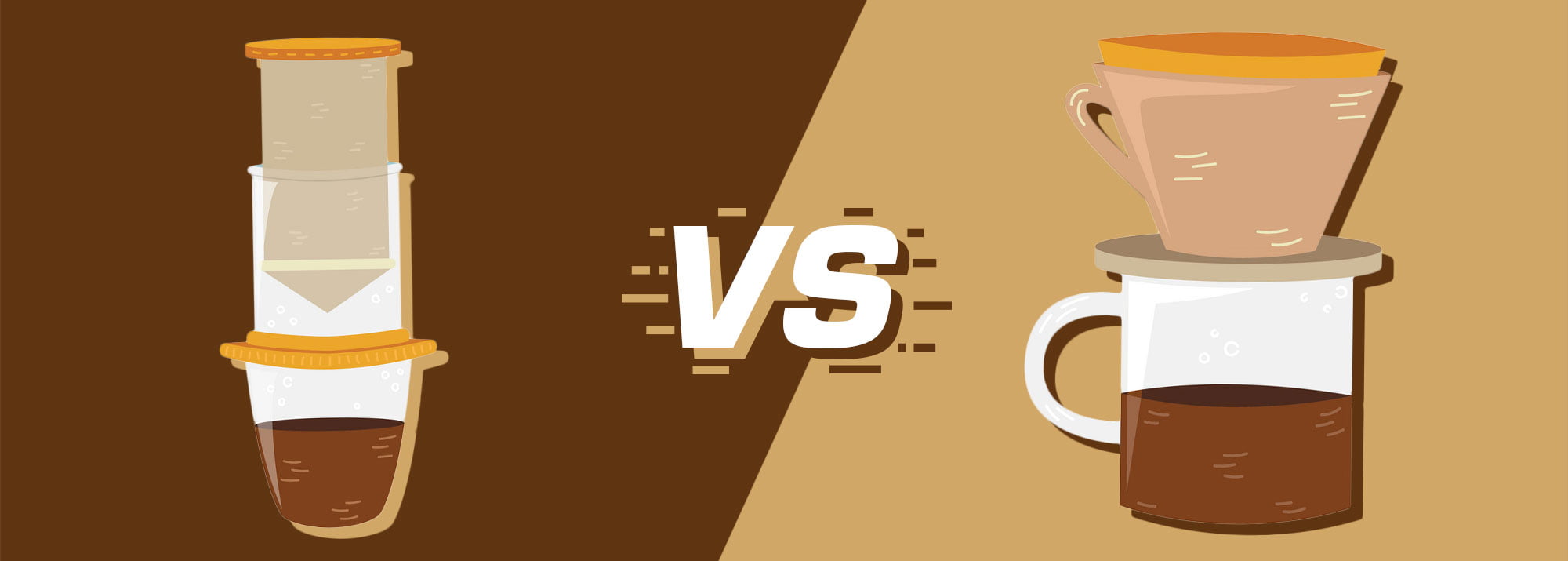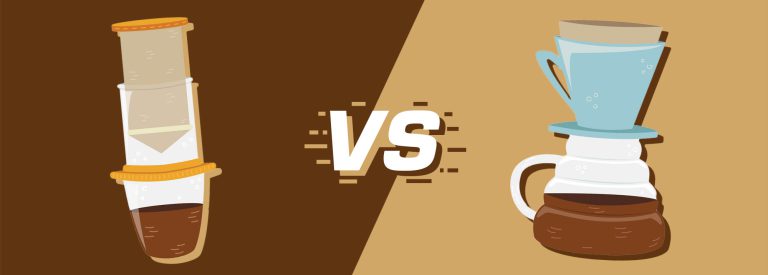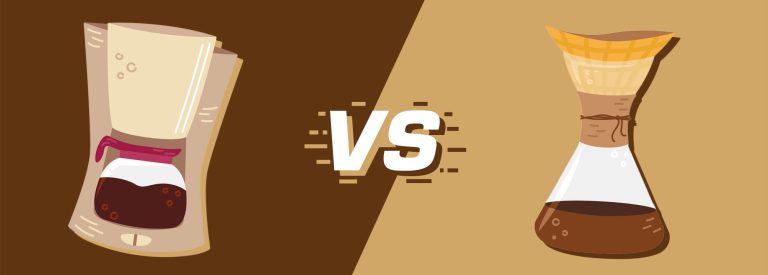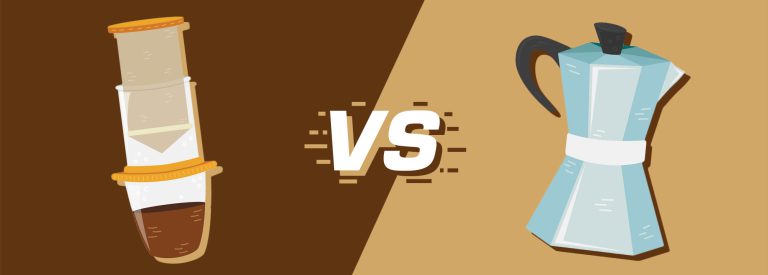AeroPress vs Pour Over – Barista’s Take: Which Brews the Better Coffee?
People who are looking for manual brewers often ask me if they should go for the AeroPress or pour-over coffee.
My answer is never short, as I try to explain the different factors that could affect one’s choice. This is why I’ve decided to just write them all down and share with everyone my knowledge about these two brewing methods.
In this article, I’ll delve deeper into both techniques and compare them side-by-side so you can finally determine which one’s for you.
Comparing AeroPress & Pour Over – Which Method is Better?
So, which is better, the AeroPress or pour over? It really depends on what you’re looking for in your coffee.
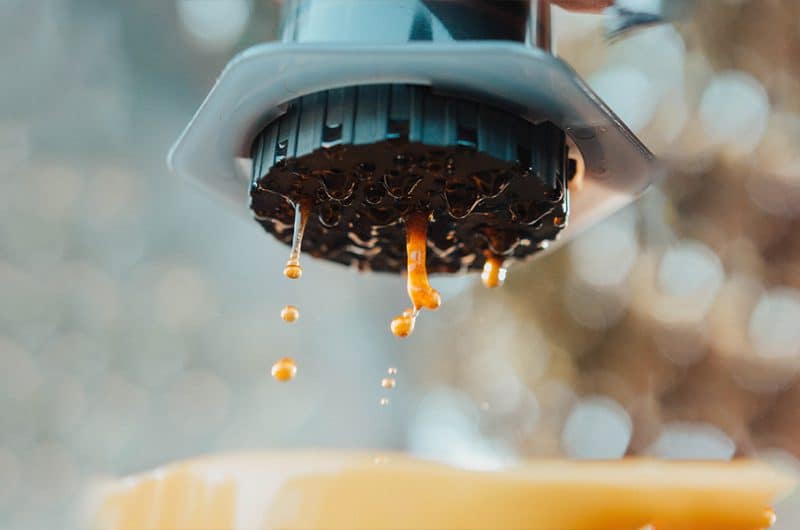
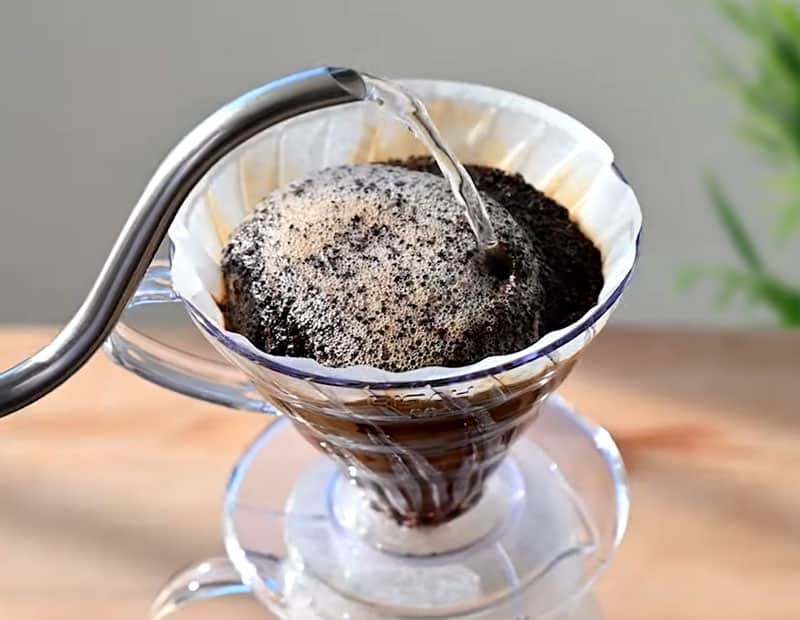
The AeroPress is a fascinating device that uses a piston to press hot water at around 1 bar of pressure through coffee grounds. It’s perfect for those who love a robust cup, as it produces an intense flavor profile with less acidity thanks to its unique extraction process.
Meanwhile, Pour Over coffee is all about precision and patience. This manual brewing method involves pouring hot water over coffee grounds slowly and steadily, allowing it to extract flavors from every nook and cranny, resulting in a smoother taste compared to other methods of brewing. Some popular tools for pour-over are the Hario V60 and Chemex.
Here are the factors to consider when picking between the two brewing methods, followed by a detailed comparison of each feature.
| Features | AeroPress | Pour Over |
|---|---|---|
| Taste & Flavor | Rich and full-flavored, various taste profiles | Clean and complex, subtle notes |
| Strength | Variable strength, from bold to light | Less intense, lighter-bodied |
| Ease of Use | User-friendly, minimal mess | Steeper learning curve, precise pouring control |
| Brewing Speed | 3 to 4 minutes | 5 to 7 minutes |
| Versatility | High control over brewing factors | Control over water temperature, flow rate |
| Durability & Portability | Sturdy, lightweight, compact | Durable, portable (varies with materials) |
| Sustainability | Plastic construction, recyclable/compostable and reusable filters | Sustainable material options, paper and reusable filters |
| Cost | $30 to $40, recurring cost for paper filters | $5 to $50, recurring cost for paper filters |
Detailed Comparison Between the AeroPress & Pour Over
Here’s a closer look at the factors that set AeroPress and pour over apart from each other.
Taste, Flavor, & Strength
The AeroPress versus Pour Over debate is a hot topic when it comes to taste and strength. As someone who enjoys crafting coffee with different methods, I could point out a number of comparisons.
- First off, let’s talk about flavors. The AeroPress produces a rich and full-flavored cup of coffee with low acidity. Based on the recipe and technique, it also has the potential for various taste profiles and strengths – from bold and strong coffee to light and delicate cups.
- On the other hand, Pour Over delivers a clean, complex flavor experience that ignites the senses with its intense aroma. Lighter-bodied than AeroPress coffee, pour over’s extraction process leaves behind oils and fines from beans for a cleaner finish – this results in less intensity.
- However, some find it preferable over Aeropress as they appreciate more subtle notes like floral or fruity undertones.
So which one tastes better? Honestly, it’s tough to say since both methods offer such unique taste experiences.
If you prefer bolder, richer flavors without as much acidity, then I’d say go for AeroPress. But if you enjoy subtler notes and aromas that are complex and intense instead of outright powerful – pour-over could be your winner.
Ease of Use
Which one is easier to use? Generally speaking, the short answer is that the AeroPress is more user-friendly even for newbies. However, you must consider how pour over coffee can also be a breeze to make.
The AeroPress is incredibly easy to use with minimal mess. All you need to do is measure out your medium-fine coffee grounds, prepare the filter, add coffee and hot water at 175°F to 205°F, then press down on the plunger when the extraction is completed.
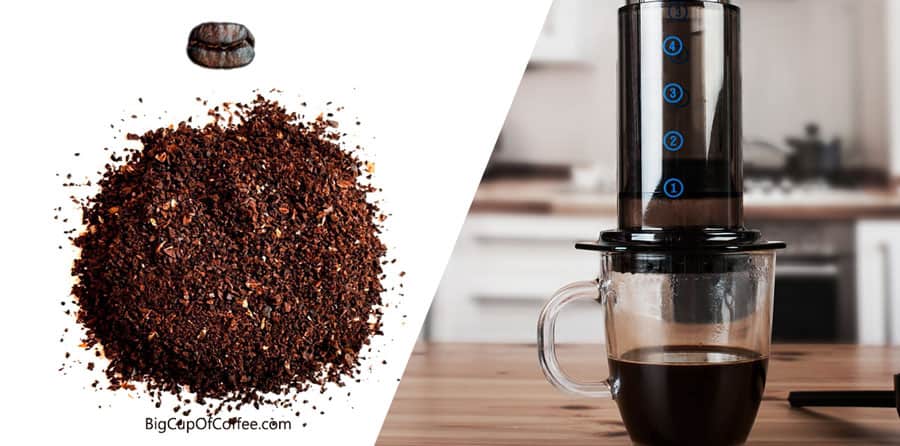
Meanwhile, pour-over has a slightly steeper learning curve at first but once you get the timings right and master the pouring technique, you’ll enjoy great-tasting coffee every time. A gooseneck kettle helps ensure precise pouring control which can be tricky at first if you’re not used to it. With pour over, a medium to medium-fine grind size and 195°F to 205°F water temperature are recommended for optimal flavor. Filter type will depend on the brewing device you’re using, but paper filters tend to be the most common.

Ultimately, both methods require attention to detail as you’re brewing so it’s all about personal preference.
Brewing Speed
Both the AeroPress and Pour Over can brew coffee pretty quick. The total time for the AeroPress is a mere 3 to 4 minutes from grinding to brewing and cleaning up. However, this may vary slightly depending on your chosen recipe since the brewing time ranges from 30 seconds to four minutes.
With Pour Over, you can expect to spend around 5 to 7 minutes in total. Aside from the preparation , it requires some blooming time before pouring the rest of the water, and you have to wait a little bit more for the drawdown.
Cleaning-wise, an AeroPress only needs a rinse of the plunger and chamber. For a Pour Over, simply rinse off the dripper after use, and you’re done. It is worth noting though that a glass dripper or a Chemex will need some extra care when you’re cleaning. But you can always just brew right into a mug, as I do 🙂
So if you’re always rushing for that caffeine kick, go for AeroPress. Although pour over isn’t bad either in fixing your cup of coffee in a jiffy.
Versatility
Versatility is crucial since it enables you to explore your creativity with different recipes and tailor each cup of coffee to your preferences. The AeroPress offers a higher level of versatility due to its ability to control all brewing factors from water temperature to pressure.
Meanwhile, pour over methods allow for decent control, enabling you to regulate the water temperature, grounds size, coffee-to-water ratio, and the flow rate as you pour your water into the coffee bed.
In terms of flexibility based on capacity, the AeroPress is pretty limited. The standard AeroPress can make up to 10 oz (290 ml) while the AeroPress Go makes 8 oz (230 ml) and the new AeroPress XL can hold up to 20 oz (590 ml). Before you go picking the upsized AeroPress though, check out my AeroPress XL review to find out if the double price is really worth your money.
Meanwhile, pour over coffee makers come in various sizes depending on your preferred choice of brewer. For example, a Chemex has four sizes that can produce up to 50 oz of coffee while the V60 has three sizes that can make up to 6 cups of coffee.
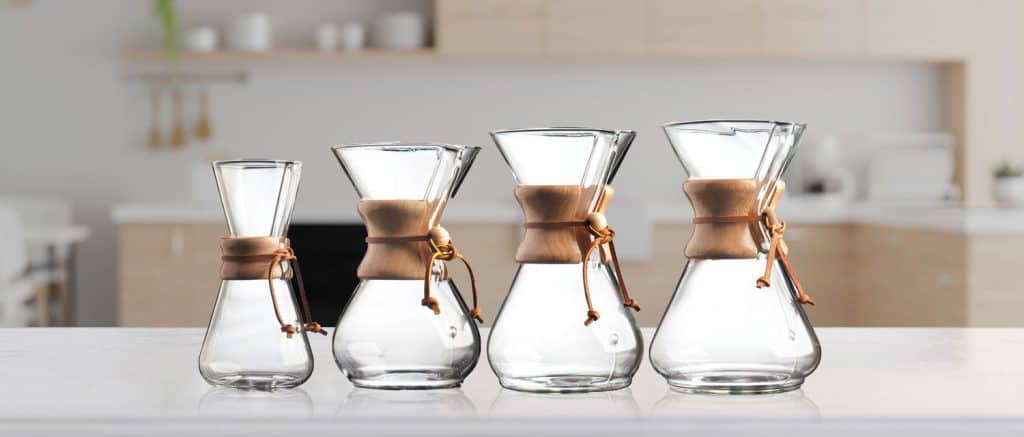
For me, the AeroPress wins when it comes to versatility. Despite its limited capacity, I love how this coffee maker can produce a wide range of flavor profiles when you tweak certain things. This is why I’m always excited to learn about new recipes like these coming from the annual AeroPress championships.
Durability and Portability
Now let’s talk durability. The plastic construction of the AeroPress not only makes it sturdy but also lightweight and compact. Its makers even made a newer variant that’s even more durable called the AeroPress Clear, which I recently wrote a review on.
If you’re someone who loves to travel like me, then I assure you that this coffee maker is such a reliable companion.
On the other hand, pour overs tend to use different materials depending on the brewer you’re using. Drippers are generally small, lightweight, and come in metal, copper, and plastic materials, making them durable and portable. Glass drippers and Chemex can be fragile though. Also, taking a gooseneck kettle on the road isn’t really an option.
Both the AeroPress and pour over drippers, made with the right material, ace the durability and portability department, so the better choice is really up to you. My vote goes to the Aeropress here.
Sustainability
Another important factor that some people might look over is sustainability in coffee makers. Whenever you fix a cup of coffee, don’t forget to consider which method is better for the planet. First off, both manual methods do not use electricity, which conserves energy.
However, the AeroPress falls short due to its plastic construction which isn’t really eco-friendly. Although the paper filters are recyclable and compostable, it is better to make coffee with reusable metal and cloth filters.
Pour over has the same issue with filters but they are often made with sustainable material options including:
- Glass
- Metal
- Copper
- Ceramic
While both options prove more sustainable than your typical drip coffee makers or pod machines, one shines brighter – pour over.
Cost
When it comes to prices, AeroPress and pour over have significant differences. The AeroPress itself ranges from $30 to $40, which is relatively affordable. However, replacement paper filters for AeroPress may add up over time, with each filter costing two cents in 2025.
As for the pour over, it has a wide price range that can go as low as $5 and maxing out at about $50 depending on the brand and brewer you choose. Paper filters can also be a recurring cost which ranges between two and eight cents right now.
While both methods have additional costs that need to be taken into consideration, a pour over is more affordable than the AeroPress in terms of long-term value for money.
But with that said, I think you’ll agree that they are both very cost-effective ways of making coffee.
AeroPress and Pour Over Weighing the Pros & Cons
Now that we’ve gotten a closer look at the features of each brewing method, here’s a quick overview of the pros and cons of AeroPress and pour over so you can finally decide which one is for you:
| Brewing Method | Pros | Cons |
|---|---|---|
| AeroPress | – Highly portable – Versatile – Produces smooth and consistent coffee – Low acidity – Fast and easy to use and clean | – Limited capacity – The plastic body is not eco-friendly |
| Pour Over | – Offers great control over the brewing method – Easy to produce consistent coffee – Fairly affordable | – Requires a bit of patience to brew – Glass brewers can be fragile – Needs extra equipment such as a kettle |
You can also check out how the AeroPress fares when compared to other brewing methods such as:
Meanwhile, here’s how pour over compares to other brewers:
So, which is better?
The better method really depends on which factors you prioritize. AeroPress wins points for being highly portable and versatile, producing smooth coffee with low acidity, while the pour over is more sustainable with multiple sizes and material choices, dripping coffee that has complex flavors.
As for me, I love to use both methods in different circumstances. Whenever I need a quick caffeine hit or when I’m traveling, I have my trusty AeroPress with me. But during peaceful mornings, I find it really satisfying to add pour over coffee to my morning ritual.
What about you, which brewing method do you prefer? Let me know in the comments below, make sure you visit my Aeropress guide, V60 guide, and Chemex guide.

